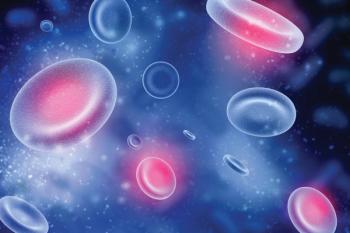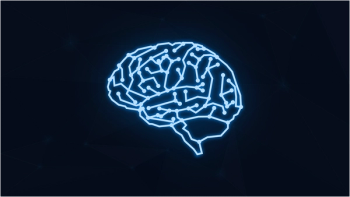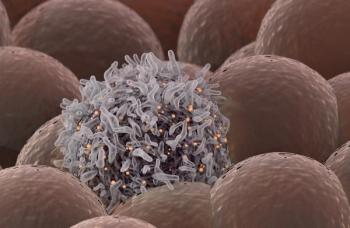
Navitoclax Plus Ruxolitinib Combo Elicits Responses Indicative of Myelofibrosis Disease Modification
Bone marrow fibrosis improvement and variant allele frequency reduction observed with navitoclax plus ruxolitinib for patients with previously treated myelofibrosis may suggest disease modification.
The combination of navitoclax plus ruxolitinib (Jakafi) led to an improvement in bone marrow fibrosis (BMF) and reduction in variant allele frequency (VAF) in patients with myelofibrosis (MF) who progressed on or had suboptimal response with prior ruxolitinib monotherapy, according to results of the phase 2 REFINE trial (NCT03222609) that were reported in a poster at the
Median overall survival (OS) was not reached (NR) in patients who had at least 1 grade improvement in BMF vs those without at 28.5 months (95% CI, 19.6-NR; P <.01). Similarly, median OS was better in those with 20% or greater reduction in VAF vs without (NR vs 28.5 month, respectively; P = .05). No deaths were observed in patients with either BMF improvement or VAF reduction.
“The association of improvements in BMF and VAF with improved overall survival are suggestive of disease modification,” Naveen Pemmaraju, MD, of The University of Texas MD Anderson Cancer Center, and co-authors of this study wrote in their poster. “The navitoclax plus ruxolitinib regimen led to improved outcomes for patients with MF regardless of HMR [high molecular risk] status.”
Despite the ability of ruxolitinib to reduce splenomegaly and constitutional symptoms associated with MF, underlying disease biology typically remains largely unchanged. Roughly half of all patients will discontinue receiving the JAK2 inhibitor after 3 years, with an expectation of poor prognosis following withdrawal of the agent.2,3 Patients with MF who harbor major hydrophilic region (MHR) mutations—such as ASXL1, EZH2, IDH1/2, SRSF2, and U2AF1 Q157—are at increased risk of experiencing leukemic transformation or premature death. Reversed BMF and VAF reduction may be linked with disease modification, but the clinical benefits of these responses have not played out in research.
The multicenter, open-label REFINE study was undertaken to determine if navitoclax with or without rituximab could lead to spleen volume reduction in patients with MF who previously received ruxolitinib monotherapy. The current analysis reports on exploratory outcomes of BMF, VAF, and HMR in patients treated in cohort 1a (n = 34) and how these correlated with efficacy end points. All patients received at least 1 dose of navitoclax starting at 50 mg/day and escalating to 300 mg daily based on tolerability plus ruxolitinib at the patient’s current stable dose. BMF was assessed locally; VAF reduction of the driver gene, either JAK2 or CALR, was assessed centrally by next-generation sequencing in the blood at baseline and 24 weeks.
Of the 32 patients evaluable for BMF, 12 (38%) had at least 1 grade improvement at any time of the study and 4 (13%) experienced a minimum of 2 grade improvements. Additionally, 26 patients were evaluable for driver gene VAF reduction, of whom 19 harbored mutant JAK2 vs 7 with mutant CALR, 6 (23%) had at least a 20% reduction at 24 weeks. Five patients had responses in both BMF and VAF.
Of the patients achieving 35% spleen volume reduction at any time, median OS was not reached in those with improved BMF (n = 9) vs 28.5 months for those without (n = 6; P <.01). Median OS was not reached in either group of patients with (n = 19) or without (n = 14) HRM (P = .45).
In total, 17 patients discontinued navitoclax because of progressive disease (n = 6), adverse effects (n = 5), receipt of transplant (n = 2), death (n = 2), physician decision (n = 1), and degrading quality of life (n = 1). In total, 33 patients had molecular risk information available and 58% were considered to be at HMR. Median follow-up in survivors was 26.2 months (range, 6.7-36.4).
Median patient age was 68 years (range, 42-86), roughly two-thirds (68%) were men, and all participants had an ECOG performance score of either 0 (47%) or 1 (53%). Median duration of prior ruxolitinib exposure was 91 weeks (range, 19-391). The median spleen volume was 1695 cm3 (range, 466-5047). Seventeen patients (52%) had 3 or more mutated genes; 26 patients (79%) presented with mutated JAK2 and 7 (21%) with mutated CALR (type 1, 57% [n = 4]; type 2, 43% [n = 3]). HMR mutations were ASXL1 (68%), SRSF2 (37%), EZH2 (21%), U2AF1 (5%), and IDH1/2 (5%); 42% had mutations in 2 or more HMR genes.
References
- Pemmaraju N, Garcia J, Potluri J, et al. Addition of navitoclax to ruxolitinib mediates responses suggestive of disease modification in patients with myelofibrosis previously treated with ruxolitinib monotherapy. Presented at: American Association for Cancer Research (AACR) 2022 Annual Meeting; April 8-14, 2022; New Orleans, LA. Abstract LB108 / 2.
- Cervantes F, Vannucchi AM, Kiladjian JJ, et al. Three-year efficacy, safety, and survival findings from COMFORT-II, a phase 3 study comparing ruxolitinib with best available therapy for myelofibrosis. Blood. 2013;122(25):4047-4053. doi:10.1182/blood-2013-02-485888
- Palandri F, Breccia M, Bonifacio M, et al. Life after ruxolitinib: Reasons for discontinuation, impact of disease phase, and outcomes in 218 patients with myelofibrosis. Cancer. 2020;126(6):1243-1252. doi:10.1002/cncr.32664
Newsletter
Stay up to date on recent advances in the multidisciplinary approach to cancer.






















































































